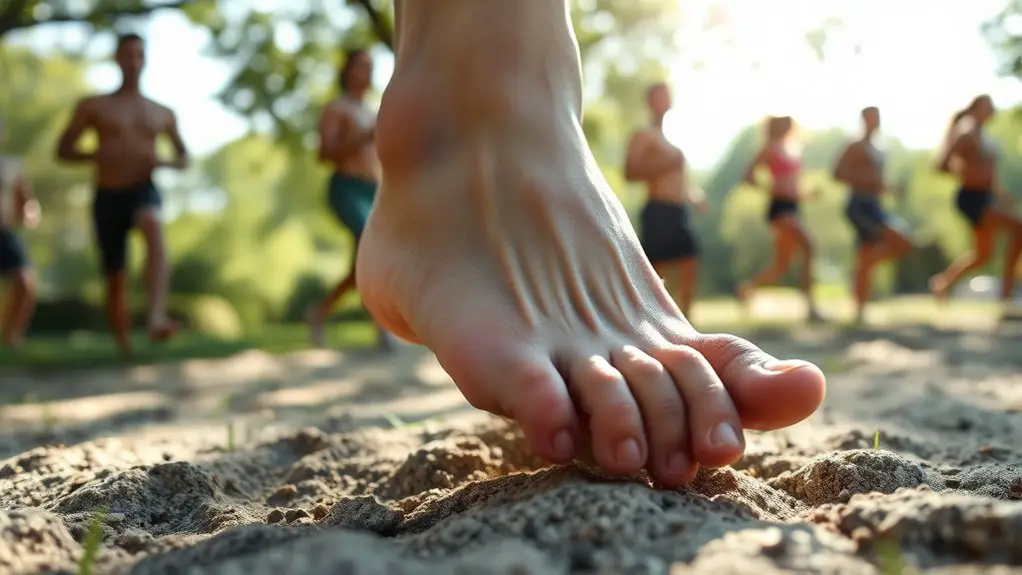To prevent Achilles tendon injuries as a runner, focus on proper warm-up and cool-down routines to enhance flexibility and blood flow. Incorporate strengthening exercises like calf raises and eccentric heel drops to build tendon strength. Pay attention to your footwear, ensuring it provides good cushioning and support. Finally, monitor your training volume and intensity, avoiding sudden increases to honor your body's limits. Keep going to learn more about effective strategies for maintaining healthy running habits.
Understanding the Anatomy of the Achilles Tendon
The Achilles tendon is a robust cord that connects your calf muscles to your heel bone, playing an indispensable role in running and jumping. Understanding its anatomy is essential for anyone who craves the freedom of movement. This tendon is the largest and strongest in your body, allowing you to push off the ground with power and agility. It's made up of collagen fibers that provide both strength and flexibility, enabling you to sprint, leap, and navigate various terrains.
Situated at the back of your ankle, the tendon absorbs stress during activities, making it crucial for performance and injury prevention. When you're aware of how it functions, you can appreciate its significance in your daily runs. Keeping your Achilles tendon healthy means you can embrace the joy of running without limits, allowing you to explore and experience the world around you with confidence and ease. To maintain its health, strengthening surrounding muscles is vital as it reduces the risk of injury and enhances your overall performance.
Common Causes of Achilles Tendon Injuries
Understanding how the Achilles tendon functions helps highlight the factors that can lead to injuries. Overuse is a major culprit; when you push your limits without adequate rest, it can easily strain this crucial tendon. Sudden increases in mileage or intensity can also trigger problems. If you're adjusting to a new running surface or footwear, that change can put extra stress on your Achilles, too.
Poor biomechanics, like overpronation or tight calf muscles, can lead to improper alignment during your runs, increasing your injury risk. Don't forget about age—your tendons naturally lose elasticity and strength over time. Additionally, incorporating regular strengthening exercises can help empower the muscles around your Achilles, reducing the risk of injury. Neglecting strength training can weaken the muscles around the tendon, making it more susceptible to injury. By recognizing these common causes, you can take proactive steps to protect your Achilles and keep enjoying your runs with the freedom you crave.
Importance of Proper Warm-Up and Cool-Down
When you prioritize a proper warm-up and cool-down, you greatly reduce the risk of Achilles tendon injuries. A good warm-up gets your blood flowing and increases the elasticity of your muscles and tendons. Just a few minutes of dynamic stretching and light jogging can prepare your body for the freedom of running. It helps your Achilles tendon adjust to the demands of the activity, preventing unnecessary strain.
Cooling down is equally essential. It helps your body shift back to a resting state, reducing muscle stiffness and soreness. Incorporating gentle stretches after your run can enhance flexibility and promote recovery. This balanced approach keeps you in the game longer, allowing you to enjoy the open roads and fresh air without the worry of injury. Remember, taking these steps isn't just about avoiding pain; it's about embracing your passion for running with confidence and ease. Additionally, stretching after workouts can significantly improve your flexibility and aid in recovery.
Strengthening Exercises for the Achilles Tendon
Incorporating strengthening exercises for the Achilles tendon is essential for every runner looking to enhance performance and prevent injuries. These exercises build resilience in your tendon, allowing you to run longer and harder without pain. Start with calf raises—stand on the edge of a step and slowly lower your heels. This works both the calf muscles and the Achilles. Aim for three sets of 15 repetitions.
Next, try eccentric heel drops. Stand on the same step, lowering your heels, then rise back up. This targets the tendon more intensely, promoting strength. Single-leg balance exercises can also help; simply balance on one foot for 30 seconds to improve stability.
Lastly, don't forget to incorporate resistance band exercises. Loop a band around your foot and push against it to strengthen the tendon and surrounding muscles. By committing to these exercises, you're investing in your running freedom and longevity. Additionally, proper warm-ups and stretching are crucial for preventing Achilles tendon injuries.
Stretching Techniques to Enhance Flexibility
Building strength in your Achilles tendon is just one part of injury prevention; enhancing flexibility is equally important. Stretching your calf muscles and Achilles tendon helps to improve your range of motion, reducing the risk of strains. Consider incorporating these techniques into your routine to keep your tendons happy and healthy:
| Stretch Type | Duration | Frequency |
|---|---|---|
| Standing Calf Stretch | 15-30 seconds | 3 times daily |
| Seated Toe Touch | 15-30 seconds | 2-3 times daily |
| Downward Dog Pose | 30 seconds | After each run |
Additionally, a strong core can enhance movement efficiency, further aiding in the prevention of injuries.
The Role of Footwear in Injury Prevention
Choosing the right footwear can greatly impact your risk of Achilles tendon injuries. The shoes you wear can either set you free to run or hold you back with pain. Here are three key features to look for:
Selecting appropriate footwear is crucial for minimizing the risk of Achilles tendon injuries and enhancing your running experience.
- Cushioning: Opt for shoes with ample cushioning to absorb shock and reduce stress on your Achilles tendon as you hit the pavement.
- Support: Seek out footwear that provides solid arch support, helping to maintain proper alignment and prevent strain on your tendon.
- Fit: Make sure your shoes fit snugly but not too tight; a proper fit allows your foot to move naturally while providing stability. Additionally, understanding your foot type can enhance comfort and help prevent injuries associated with improper footwear.
Monitoring Training Volume and Intensity
When it comes to preventing Achilles tendon injuries, monitoring your training volume and intensity is essential. You should focus on a gradual progression strategy, allowing your body to adapt to increased demands. Always listen to your body's signals, as ignoring them can lead to setbacks. Incorporating rest days into your training routine is crucial for muscle recovery and injury prevention.
Gradual Progression Strategy
A gradual progression strategy is essential for preventing Achilles tendon injuries in runners. By carefully monitoring your training volume and intensity, you can enjoy the freedom of running without fear of injury. Here are three key steps to follow:
- Increase mileage by no more than 10% each week – This helps your body adapt without overloading it.
- Incorporate rest days – Allow your muscles and tendons to recover, giving them time to strengthen.
- Mix in cross-training activities – Engage in low-impact exercises like swimming or cycling to balance your training while reducing strain on your Achilles.
Listen to Your Body
How do you know when to push through a run and when to back off? Listening to your body is key. If you're feeling sharp pain or unusual fatigue, it's your body telling you to ease up. Ignoring those signals can lead to serious injuries, like Achilles tendonitis. Keep an eye on your training volume and intensity; sudden increases can overwhelm your muscles and tendons. Instead, pay attention to how your body feels during and after runs. If you're consistently sore or fatigued, consider taking a rest day or swapping in a low-impact activity. Freedom in running comes from knowing your limits and respecting them. Trust yourself—you'll enjoy your runs more and stay injury-free.
Frequently Asked Questions
How Long Does It Take to Recover From an Achilles Tendon Injury?
Recovery from an Achilles tendon injury usually takes several weeks to months, depending on severity. You'll need to rest, rehabilitate, and gradually return to activity. Listen to your body; it knows what it needs.
Can I Run With Mild Achilles Tendon Pain?
If you feel like a gladiator ready for battle, running with mild Achilles pain isn't wise. It could worsen your condition. Listening to your body and resting is key to maintaining your freedom and mobility.
What Are the Signs of a Torn Achilles Tendon?
If you've torn your Achilles tendon, you might feel sudden pain, swelling, and difficulty walking. You may also notice a popping sound or a gap above your heel. It's essential to get it checked out!
Should I Use Ice or Heat for Achilles Tendon Pain?
When your Achilles feels like a tempest, ice can be your soothing breeze, numbing pain and reducing swelling. Heat, on the other hand, warms the storm, promoting blood flow and healing. Choose wisely, and listen to your body.
Are There Specific Races or Distances That Increase Injury Risk?
Certain races, especially longer distances like marathons, can increase your injury risk due to prolonged stress on your body. It's essential to know your limits and listen to your body to avoid setbacks.




